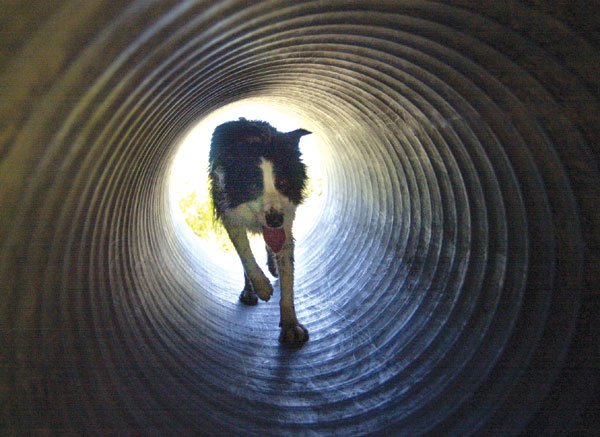Gilroy trainers turn man’s best friends into heroes; teams sent
to hurricane ravaged Gulf Coast
Gilroy – Zoey climbed over a pile of wood pallets, at times wavering, but moving with caution until she reached the top of the large heap of scattered wood. The black and white border collie let out a stream of barks. She had found her target and was rewarded.
Zoey is one of 10 dogs in Gilroy who are training to be search and rescue canines. Sundowners Kennel in Gilroy is more than just a place to board dogs or to teach disobedient house pets to behave. Mother-and-daughter team Pluis and Kate Davern turn dogs into heroes.
“Good girl Zoey,” Kate said, from inside a tube where she was hiding as part of Zoey’s afternoon training. She was rewarded with a game of tug-of-war for completing her task.
Dogs such as Zoey who have completed their training and received advanced certification by the Federal Management Agency team have been deployed to the hardest hit areas after Hurricane Katrina. Of the canine teams deployed to the Gulf Coast, 26 of the dogs and handlers trained in Gilroy.
There are unique complications for the canines and their handlers in the flooded areas. Pluis has kept in close contact with at least one team deployed to the disaster. Debra Tosch, executive director of the National Disaster Search Dog Foundation, has called Pluis with concerns a few times since her deployment with her black Labrador Abby.
“The weather, the humidity and the toxicity in the water,” Pluis said of some of the issues in Mississippi and Louisiana search areas. “There is oil, gasoline and agricultural products.”
Kate added that the pair has experimented with using muzzles on dogs during searches to keep them from drinking toxic water. But because dogs need to pant to release body heat, they quickly learned muzzles were not an option.
“If you put a muzzle on a dog in hot weather, their temperature rises rapidly,” Pluis said.
At the scene along the gulf coast, medical supplies and medic vacs for decontamination are being used for dogs as well as humans. Regardless of their successes or failures. At the end of each day, handlers at the scene plan a positive rescue for each dog, where a fellow handler hides in rubble and is found. This helps keep them motivated.
The first dogs sent to the scene Aug. 30 – from Florida and Ohio – were relieved by California teams last week.
The Daverns, with the help of Jane Devlin, have been training search and rescue dogs with the National Disaster Search Dog Foundation since 1995. More than 80 percent of the dogs that have received advanced certification from FEMA in California graduated from their training program and 40 percent of the dogs nationwide came through their kennel, Pluis said.
She first worked with search and rescue dogs as a handler when she lived in Santa Cruz. In the early ’80s, she and her golden retriever searched the Santa Cruz mountains for signs of life after a deadly mudslide. Pluis found the search and rescue work, which proved fruitless much of the time, haunted her for months to come.
“Firefighters deal with it better,” Pluis said, with their training which provides for handling disastrous scenes. “I recognized my worth is in the training.”
In 1991, she opened the Sundowners Kennel in Gilroy, and when Wilma Melville, an Ojai resident, founded NDSDF she turned to Pluis as their exclusive trainer. Part of the work of the foundation is to raise money to train the dogs, which can cost up to $10,000 per dog. The dogs taken in by the foundation for Sundowners training program often come from shelters or other rescue groups.
“These are dogs who would be unadoptable,” said Pluis.
“We have the ability to take dogs that would otherwise not have a job,” Kate said. “We put them to work to do something other than destroy your house.”
High energy and the desire to retrieve are some signs Kate and Pluis look for when choosing dogs for their training program. They also check the dogs for health issues, such as hip dysplasia, and some dogs are still removed from the program months into the training.
A common problem for dogs, Pluis and Kate said, is that they lose their high play drive after they’ve been given months of attention. When they no longer want to retrieve and search, they have to be taken out of the program. The foundation does have a lifetime care promise to their canines, so they find permanent homes for each dog that doesn’t complete training.
After nine months of training, Zoey’s drive to retrieve hasn’t diminished and she is still moving along in the program. She works with her trainers every day and doesn’t give up even when she nearly falls off a metal ladder during her agility training. And when she got to the top of a ladder, she walked across a plank, and descended another set of steps. At the end of each exercise, Kate or Pluis rewarded her with a game of fetch with a tug toy.
Though Zoey is still training, she could some day be deployed with her firefighter handler to a disaster area. And while she will be able to search out human life in a way people would never be able to, her presence serves another purpose.
“At a disaster area, workers get so tired and emotionally so depleted,” Pluis said. “At the end of the day, you could hug a fire engine all you want and it’s not going to give anything back. But hug your dog and you are replenished.”
For more information on the National Disaster Search Dog Foundation or to donate money, please call 888-459-4376 or visit www.searchdogfoundation.org.














